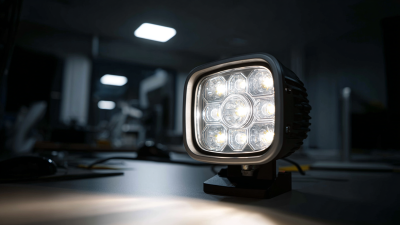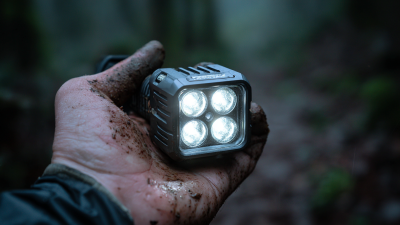Leave Your Message
In recent years, the demand for efficient and durable lighting solutions has led to a significant rise in the popularity of LED work lamps, as evidenced by a report from the Lighting Research Center, which indicates that LED lighting can consume up to 75% less energy than traditional incandescent bulbs. With advancements in technology, LED work lamps have become essential tools across various industries, including construction, automotive, and home DIY projects. A market analysis by Grand View Research forecasts that the global LED work light market will reach $4.47 billion by 2025, highlighting the growing reliance on these versatile lighting solutions. Choosing the perfect LED work lamp tailored to your specific needs is crucial for maximizing productivity and ensuring safety in work environments. In this ultimate guide, we will explore the key factors to consider when selecting an LED work lamp, ensuring you make an informed decision that meets your unique requirements.

When it comes to choosing the perfect LED work lamp, understanding the various types tailored for different applications is essential. LED work lamps come in myriad forms, including portable, rechargeable, and permanently mounted options. For instance, portable LED lamps are ideal for users who need flexibility on job sites, while rechargeable units offer convenience and are often designed for outdoor use. Permanent fixtures, on the other hand, are suitable for workshops and garages where consistent lighting is required.
Tip: When selecting an LED work lamp, consider the brightness (measured in lumens) required for your specific task. A higher lumen count will give you stronger light, which is especially beneficial for detailed work or larger areas.
Different designs also cater to specific environments. For example, explosion-proof designs are crucial in hazardous workplaces, while waterproof models are perfect for outdoor conditions. Assessing the environment in which you will use the lamp will help narrow down your options effectively.
Tip: Always check the lamp's durability and power source. Some lamps come with features like protective lenses or rugged designs, which enhance longevity, making them a worthwhile investment for demanding jobs.
This chart represents the brightness (in lumens) of different types of LED work lamps based on their applications. Understanding the brightness levels can help you select the right lamp for your specific needs.
When selecting an LED work lamp, the first key feature to consider is brightness, measured in lumens. Higher lumens indicate a brighter light, which is crucial for tasks that require precision, such as electrical work or detailed carpentry. A lamp with adjustable brightness settings can provide versatility, allowing you to switch between low light for close-up tasks and high light for larger work areas.

Another important aspect is battery life, particularly if you require portability. Work lamps that offer extended battery life enable you to work for longer periods without the need for constant recharging. Look for options that provide both rechargeable and plug-in capabilities for added convenience. Additionally, consider the design and durability of the lamp. A lightweight, compact lamp with features like a magnetic base or a hook can enhance usability in different environments. Waterproof or impact-resistant ratings are also beneficial if you plan to use the lamp in harsh conditions.
When selecting the ideal LED work lamp, evaluating brightness and color temperature is crucial for ensuring optimal illumination in your workspace. Brightness is typically measured in lumens, with higher lumen output providing greater light intensity. According to a report by the Illuminating Engineering Society, for tasks requiring precision, such as detailed assembly or repair work, a minimum of 500 lumens is advisable. However, for general tasks, a range of 100-300 lumens should suffice. This understanding helps in picking a work lamp that complements the task at hand, thereby enhancing productivity and reducing eye strain.
Color temperature, measured in Kelvin (K), plays an equally significant role in creating an effective work environment. A color temperature around 4000K to 5000K offers a balanced, neutral white light that closely resembles daylight, which is ideal for most work tasks. Research from the Lighting Research Center indicates that cooler lighting, around 5000K, can boost alertness and concentration, leading to improved performance.

Tips: When choosing a work lamp, consider investing in adjustable options that allow you to modify both brightness levels and color temperatures based on the specific requirements of your tasks. Additionally, ensure that your LED work lamp has a high Color Rendering Index (CRI) above 90 for true-to-life color representation, which is essential for tasks requiring color accuracy.
When choosing between portable and stationary LED work lamps, it’s essential to weigh their respective pros and cons to determine the best fit for your specific needs. Portable LED work lamps offer unmatched flexibility, allowing users to easily move the light where it’s needed most. According to a report by the U.S. Department of Energy, portable LED fixtures use up to 75% less energy than traditional halogen lights, making them not only cost-effective but also an environmentally friendly option. This feature is particularly beneficial on job sites that require frequent relocation or adaptable lighting configurations.
On the other hand, stationary LED work lamps excel in providing consistent, high-quality illumination where it matters most, making them ideal for workshops and fixed installation scenarios. The National Electrical Manufacturers Association highlights that stationary LED lights have longer lifespans, often exceeding 50,000 hours, which significantly reduces the frequency of replacements and maintenance. Additionally, stationary models can offer higher lumen outputs, ensuring that large areas are adequately lit for more extensive applications, such as automotive repairs or construction projects. Both options present unique advantages, making the decision ultimately dependent on the specific tasks and environments in which the lamps will be employed.
| Feature | Portable LED Work Lamps | Stationary LED Work Lamps |
|---|---|---|
| Mobility | Highly portable; easy to move | Fixed location; limited mobility |
| Brightness Options | Variety of brightness settings | Typically high lumens for large areas |
| Power Source | Battery-operated or rechargeable | Hardwired or plug-in |
| Durability | Generally more rugged | Can be more delicate; designed for long-term use |
| Cost | Moderately priced; budget-friendly options available | Higher initial investment |
| Ideal Use Cases | Outdoor use, maintenance, temporary jobs | Workshops, garages, or fixed workplaces |
| Light Quality | Flexible angles and adjustable beams | Consistent lighting; better for detailed work |
When considering the purchase of a high-quality LED work lamp, budgeting plays a crucial role in ensuring you make a wise investment. Start by determining your specific needs; consider the tasks you'll be performing, the environment you'll be working in, and the amount of light required. This helps you set a realistic budget that reflects both the features you need and the quality you expect.
Next, research different brands and models within your budget range while paying attention to the specifications that matter most. Look for essential features such as brightness levels, durability, portability, and battery life. Additionally, check for warranties and customer reviews, as they can provide insights into the lamp's performance and reliability. By being thorough in your research, you can maximize your investment and select an LED work lamp that meets your requirements without breaking the bank.






